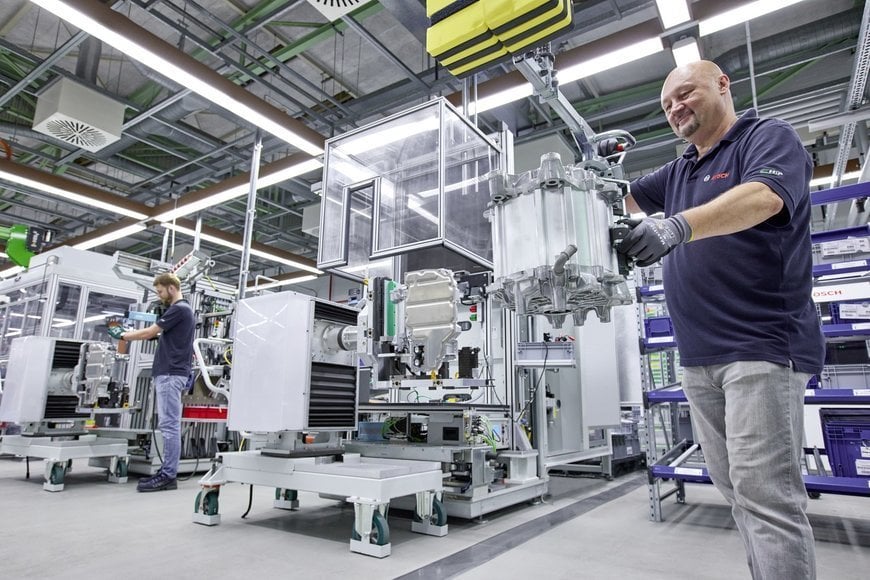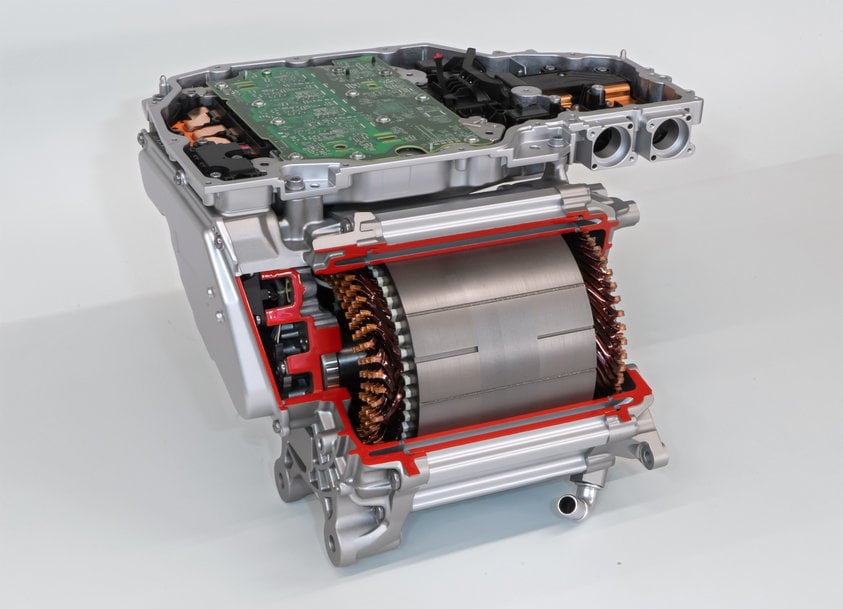E-mobility for the last mile Bosch launches new electric drive for light commercial vehicles
Vans and medium-sized trucks are the beating heart of urban goods traffic. Powered electrically, they are locally emission-free, contribute to better air quality and reduce noise pollution for residents. Bosch is now starting volume production of a new drive unit for such light commercial vehicles, consisting of an electric motor and an integrated inverter.

- Compact drive module includes electric motor and inverter
- Greater range and improved efficiency thanks to new power semiconductors
- Drive module now launched at customer
The inverter controls the electric motor and provides the connection to the high-voltage battery. “Bosch is driving forward e-mobility also in commercial vehicles. Compared to its predecessors, the new unit provides even higher power and torque density and is even lighter and more compact,” says Dr. Markus Heyn, member of the Bosch board of management and chairman of the Mobility Solutions business sector. Together, the motor and inverter weight is around 80 kilograms. Bosch has reduced electrical losses by more than 20 percent using new power semiconductors, which enables an inverter efficiency level of 97 percent, thereby increasing the vehicles’ range. Thanks to the flexible construction, it is also now even easier to integrate the drive module into existing and new vehicle models.
The electric drive will make its debut at the customer Daimler Truck, supplemented by a DC/DC converter and the vehicle control unit from Bosch for the drivetrain. The unit’s maximum power is 129 kW, while the continuous power is 100 kW. For a short time, the permanent-magnet synchronous machine can generate a peak torque of 430 Nm. Even at a vehicle weight of 8.5 tons, this ensures superior driving performance in every situation – including in hilly cities such as Tokyo, Rome, or San Francisco.
Bosch is driving forward e-mobility also in commercial vehicles. Compared to its predecessors, the new unit provides even higher power and torque density and is even lighter and more compact” says Dr. Markus Heyn, member of the Bosch board of management and chairman of the Mobility Solutions business sector.
A good basis made even better
The Bosch engineers have based the design of the electric motor and the inverter on the technology used in the passenger car segment. This not only speeded up the development phase considerably, but also helped cutting costs. By embedding the electric drive module in the vehicles’ existent water-cooling circuit, an oil-based cooling circuit is no longer necessary. Furthermore, the high rotational speed of the electric motor ensures a single-speed transmission to be sufficient to meet all requirements. The smaller dimensions of the new electric drive mean that a battery made up of a single part can now be used. New microcontrollers offer considerably more computing power to process the complex control algorithms of the electric drive within milliseconds. In this context, the software is largely responsible for the behavior of the electric drive and can be tailored to customers’ specific requirements. The drive module will roll off the production line in Hildesheim, Germany, the Bosch lead plant for electric drives.

Wide range of products and high level of investment
“Bosch has already invested over five billion euros in e-mobility,” says Heyn. Since 2018, the company has acquired 170 production projects. Sales revenue is expected to exceed the five-billion euro mark in 2025. Bosch has a broad portfolio of products available to customers, ranging from individual sensors, electric motors, power electronics and electronic control units to integrated solutions such as the eAxle, right through to pre-integrated modules. The advanced driving module, for example, which integrates the drive, steering and brakes, offers simplified interfaces and thus improves communication between the components. This ensures optimal interplay between the electric vehicle’s systems and subassemblies – e.g., in terms of vehicle stabilization or energy recuperation, as well as a significantly shorter time-to-market. As a result, both established manufacturers and new providers can get their electric vehicles on the roads quicker than ever before.
More information
BOSCH PRESS CONFERENCE: Monday, September 19, 2022, from 11:10 to 11:30 CEST: with Dr. Markus Heyn, member of the Bosch board of management and chairman of the Mobility Solutions business sector, at the Bosch booth B22 in hall 20 and via livestream on the Bosch Media Service.
Panels with Bosch experts at the IAA Conference:
1. Tuesday, September 20, 14:15 – 15:15 CEST in the Industry Forum:
Presentation:“How to manage the operational challenges of multi-brand commercial EV fleets” by Michael Köhler, Senior Vice President Business Unit Battery, at Robert Bosch GmbH
2. Tuesday, September 20, 17:30 – 17:45 CEST on the Main Stage:
Keynote: “Powertrain solutions for future transportation” by Jürgen Häusser, Vice President Product Management Commercial Vehicle & Off-Road at Robert Bosch GmbH
3. Wednesday, September 21, 17:00 – 19:00 CEST at the Cummins booth (hall 20, booth A12):
“Open dialog on the hydrogen engine” with Dr. Andreas Kufferath, Engineering System Diesel Powertrain at Robert Bosch GmbH
4. Thursday, September 22, 11:30 – 12:00 CEST on the Main Stage: Presentation:
“Global digitization in logistics” by Mariella Minutolo, Executive VP Progressive Mobility Players at Robert Bosch GmbH
www.bosch.com

